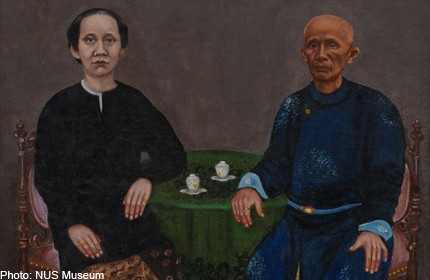Peranakan portraits

You might do a double take at a new exhibition of Peranakan family portraits dating from the late 1800s. Amid more than 50 portraits, there is just one painting of a Nonya in the iconic kebaya, an outfit everyone associates with the Peranakan community.
This is because wearing the form-fitting sarong kebaya was seen to be as daring as wearing a mini skirt at one point in history, says Ms Foo Su Ling.
She curated Inherited & Salvaged: Family Portraits From The Straits Chinese Collection, which opened on Wednesday at the National University of Singapore Museum.
"Even though the kebaya seems traditional to us today, it was then a response to modernity, where the modern girl would wear a shapely blouse paired with a form-fitting sarong," explains Ms Foo, 51.
That sole portrait from 1949 shows an unnamed woman in a cream lace kebaya from Java, Indonesia; while other pieces depict Peranakan women in the baju panjang, a shapeless long robe of batik cotton; the baju koo-sah, which is adapted from the Chinese blouse and trousers; and the classic baju kurung.
There are 57 pieces on display dating from the late 1800s to early 1900s, donated to the museum from 2008 by donors such as Agnes Tan, the last surviving child of Straits-Chinese community leader Tan Cheng Lock; Wee Lin, a previous owner of the NUS Baba House; and art historian and writer Peter Lee, who is also a nephew of Agnes Tan.
The exhibition is the second in a two-part series that showcases portraits of the Peranakan Chinese community in the 19th and early 20th centuries, with the first show last year at the NUS Baba House exhibiting a smaller collection of portraits and focusing on the theme of changing fashions of the Peranakans, who are Straits-born Chinese and descendants of early Chinese immigrants who married native Malay women.
Presenting the early portraits does not just tell the stories of the sitters, but also of the artists and photography studios, says Mr Ahmad Mashadi, 47, head of the NUS Museum.
"In Singapore, portraits from the period are relatively not well represented in public institutions... and they are important cultural materials that help us understand a society that is undergoing quite profound social and economic transformations," he says.
Apart from Straits-Chinese community stalwarts such as Tan Jiak Kim and Wee Boon Teck, more than half of the portraits come from dealers who could not identify the subjects.
Also on display are a set of unidentified photographs bearing the wear and tear of time, as they were found damp and stacked together, says Ms Foo.
"The family may know who the subject is, but after the photos were abandoned, this vital information becomes lost," she says.
"For these portraits, it is not about what happened during the sitter's lifetime, but very much about what happened after that."
View it
INHERITED & SALVAGED: FAMILY PORTRAITS FROM THE STRAITS CHINESE COLLECTION
Where: NUS Museum, University Cultural Centre, 50 Kent Ridge Crescent
When: Till July next year, 10am to 7.30pm on Tuesdays to Saturdays, 10am to 6pm on Sundays. Closed on Mondays and public holidays
Admission: Free
Info: Call 6516-8817
keziatoh@sph.com.sg

Get a copy of The Straits Times or go to straitstimes.com for more stories.